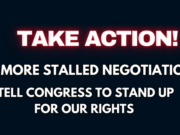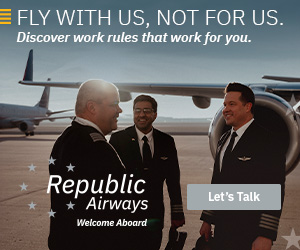 Professional Pilots of Tomorrow’s (PPOT) Positive Rate series focuses on ways to continuously improve our careers as aviators. “Positive rate” is the callout used by most airline crews to indicate the aircraft is moving in the correct direction and the gear can be raised for flight. As such, the series focuses on ways to ensure our careers are continuously moving in the best direction, or in a “positive rate.”
Professional Pilots of Tomorrow’s (PPOT) Positive Rate series focuses on ways to continuously improve our careers as aviators. “Positive rate” is the callout used by most airline crews to indicate the aircraft is moving in the correct direction and the gear can be raised for flight. As such, the series focuses on ways to ensure our careers are continuously moving in the best direction, or in a “positive rate.”
As mentioned many times before – and likely again – airline hiring has a way of leaving people terribly confused about the process. To be more specific, pilots are often left wondering what exactly an airline is looking for in the people they hire. Further, people often wonder why they don’t get a call for an interview from a certain company. Both the airlines and general aviation operators can be incredibly vague about who meets their standards. Although there is something positive to be said for not placing everyone on a generic scale, it also leaves us in the dark about how to woo a potential employer and present ourselves as the pilot they would want to hire.
Admittedly, employers of pilots have a tough job differentiating among thousands of applicants with very similar résumés and qualifications in order to pick the few whom they believe will succeed and thrive in their operation. As they continually complete this process, companies generally tend to develop an affinity for a certain type of pilot candidate. Over the tens, hundreds, or thousands of pilots an operator hires, trends start to develop about the kind of people they prefer. These trends can include types of experience, personality traits, résumé items, and a long list of other factors. As you meet, talk to, and fly with enough people who are hired by a certain airline, the patterns become apparent allowing you to discern why one was hired by their airline. Further, it can be (but isn’t always) telling when you spend time with someone who wasn’t successful at being hired by a particular airline.
So, if airlines and other aviation companies know the profile of the successful candidate, why don’t they just publish this information outright? Well unfortunately, it’s not that simple. Affinities for types of people often develop subconsciously over long periods of time, and are constantly evolving. Companies are almost always tweaking their hiring preferences and processes in an attempt to consistently bring in groups of ideal new hires. These preferences combine with hiring metrics to formulate the processes to attract and hire a company’s ideal candidate. Companies are incredibly tight-lipped about their metrics, whether they have been the product of a consulting firm, or the result of analyzing large amounts of data from their own hiring and training history. In the end, we’re not going to be able to crack the code of those specific metrics which leaves us looking at the profile trends, or the “ideal candidate” type.
Now, when people analyze airline hiring processes, they often try to dissect interview questions or lines on an application. Although that serves a valid purpose, it’s more at a micro scale. What you want to look at is the larger scale and how you shape up holistically as a candidate in the eyes of the company and its pilot selection team. That said, there are a couple simple but beneficial things you can do to help yourself become your dream airline’s ideal candidate. Even better, these practices are 100% free, and are things that any pilot can do.
The first and probably easiest way to assess a company’s pilot hiring preferences is to study their job posting. Admittedly, there may be less information than for non-airline jobs, but there’s still some information we can gain from the rather generic postings airlines offer. Examine the minimum and preferred qualifications and experience. Usually, you’ll need to meet all of the basic minimums before you’re eligible for hire. Minimums are established for many reasons, insurance and/or contractual, for example, but you won’t typically find many exceptions for having to meet the minimum requirements. If you don’t yet meet the minimums, put yourself in a position to work on your deficiencies as soon as possible. Some of these qualifications will likely include flight times, education level, additional certifications, volunteer experience, plus any from a laundry list of other qualities. Once the minimums have been met and you check off many of the “preferred” qualifications listed, you can take comfort knowing you’re likely competitive within the applicant pool. Your goal should be to exceed the minimum qualifications and possess as many of the preferred qualifications as possible. This will earn guaranteed points when a company scores your application.
Enough with the basics and we’re on to the juicy part of the job posting. When we’re lucky, a company comes right out to simply state what they’re looking for in an applicant. This part of the posting might include phrases such as self-motivated, works well in a crew environment, experienced leader, or manages duties and projects unsupervised. If they provide insight like this, we want to make sure to tailor the application materials we submit to reflect the traits they seek. For example, let’s say a company is looking for someone to manage and fly an airplane in an unsupervised position, and the job posting places an emphasis on being able to be self-directed and work unsupervised. You’ll want to make sure to highlight any jobs or experience in which you have successfully managed tasks and projects by yourself. This will give the company confidence in knowing that you’ve done this kind of thing before and were successful doing so. It probably goes without saying that should you be invited for an interview, it would be to your benefit to be able to share stories that highlight experiences that relate to the traits they’re looking for. You’ve worked years toward your achievements, so do your best to convey your relevant experiences to the airline interviewers.
Sounds easy enough, but what if a company doesn’t offer up exactly what they’re looking for in the people they want to hire? That’s where we have to read a little further into the job description. Many companies – airlines especially – simply don’t write catch phrases like the above mentioned, but may still provide a job description and/or list items that are considered when reviewing an application. A company might mention that they consider things such as leadership experience, volunteer activities, additional job duties, and other qualities when reviewing applications. If they do, then you’ll want to try to strengthen your application with as many of these items as you have accomplished. If you’re feeling a little deficient in any of the areas mentioned, then seize all opportunities to gain valuable experience in the categories they specify.
 To summarize, analyzing the job posting to be able to make a list of all the desired experience, traits, and other items a company is looking for. From that list, you should be able to relate your traits and experience on your application.
To summarize, analyzing the job posting to be able to make a list of all the desired experience, traits, and other items a company is looking for. From that list, you should be able to relate your traits and experience on your application.
The second, and most telling way to discover what your dream airline looks for in the people they decide to interview and eventually hire, is to talk to and spend time with pilots who have participated in the company’s hiring process. Although pilots often have the reputation of simply being clones of each other, every one of us has a different set of experiences, personality, style of flying, behavioral traits and leadership approach. These differences are what make some people successful going through a company’s hiring process, and others not. These differences are exactly what you want to discover in your interactions with those who have been through a company’s hiring process. Try to detect patterns that may indicate what a company might have liked or not liked.
If you work/fly enough, you’re going to run in to a lot of pilots, especially if you commute. These times are your opportunity to interact with people from a lot of different airlines. Pay particular attention to those from the airlines by which you want to be employed. Next time you run in to a pilot from one of your target airlines, instead of just shooting the breeze, try to involve yourself in meaningful conversation. Try to pick up on their personality traits and pay attention to behavioral patterns. Ask them some simple and casual questions about their experiences and any non-flying activities they’re involved in. What kind of experiences and qualifications did they have before joining their airline? Do they volunteer for any aviation organizations? What do they do beyond flying the line? What do they think got their application pulled for the interview? Show genuine interest but avoid having your questions become an interview. Keep it casual and keep the questions indirect and they’ll probably be willing to talk with you at length. You would be hard pressed to find a pilot who won’t engage in a little bragging when given the chance. Many will offer a few of their own tips on how to grab the attention of the hiring department at their company.
If you happen to ride in the jump seat on your target company’s aircraft, you’ll have an exceptional glance into how their pilots operate. There’s no better opportunity to see a company’s employees in their “natural habitat” than to see them flying the line. Not only do you gain exposure into their personalities and leadership styles, but you’ll see their tendencies, flying skills, and the decision-making abilities that caught the attention of their employer. Make special note of how they interact with their fellow crew members. This often exemplifies the type of personality that can be conveyed in an interview. For example, is it calm and relaxed, or is it more structured and formal? Neither is necessarily wrong, but different airlines might prefer different styles. What kinds of decision making processes are used on the flight deck? (These are often tested in some part of the interview.) Details such as these are great to note and can offer insight into what a company is looking for in a pilot. Simply put, can you see yourself as someone who would fit into their operation? Why or why not? Can you align your behavioral and leadership traits more closely with those your dream airline prefers? Note the positive aspects they exhibit and see how you can incorporate those into how you present yourself on the flight deck and to potential employers.
If you pay attention and use these simple strategies long enough it will become apparent what type of people an airline prefers. Subtle differences may not seem big enough to have an impact in an interview, but remember airlines are splitting hairs to separate the successful from the rest. It makes sense to keep notes on the airlines you’re pursuing. Keep a list of activities their pilots are frequently involved in, things you liked about the people with whom you interacted, and the collection of application tips you’ve been given. All these can all combine to give you a great idea of what you can do to improve your chances of getting a call from your dream employer. These are just a few examples and there are many, many more. While the strategies mentioned throughout this article may not get you an interview tomorrow, these are the little things we can do to make ourselves more likely to be noticed. In an industry as competitive as aviation, a little extra effort in preparation for all the hours we spend on applications could make all the difference. www.theppot.org. ACN
























































